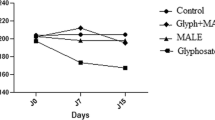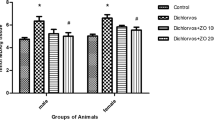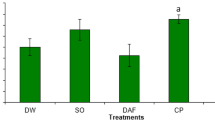Abstract
The herbicide “Roundup” is used extensively in agriculture to control weeds. However, by translocation, it can be deposited in plants, their proceeds, and the soil, thus provoking organ toxicities in exposed individuals. Neurotoxicity among others is one of the side effects of roundup which has led to an increasing global concern about the contamination of food by herbicides. Xylopia aethiopica is known to have medicinal properties due to its antioxidative and anti-inflammatory properties, and it is hypothesized to neutralize roundup-induced neurotoxicity. Thirty-six (36) Wistar rats were used for this study. The animals were shared equally into six groups with six rats each. Glyphosate administration to three of the six groups was done orally and for 1 week. Either Xylopia aethiopica or vitamin C was co-administered to two of the three groups and also administered to two other groups and the final group served as the control. Our studies demonstrated that glyphosate administration led to a significant decrease in antioxidants such as catalase, superoxide dismutase, glutathione, and glutathione peroxidase. We also observed a significant increase in inflammatory markers such as tumor necrosis factor-α, interleukin 6, C-reactive protein, and immunohistochemical expression of caspase-3, cox-2, and p53 proteins (p < 0.05). However, Xylopia aethiopica co-administration with glyphosate was able to ameliorate the aforementioned changes when compared to the control (p < 0.05). Degenerative changes were also observed in the cerebellum, hippocampus, and cerebral cortex upon glyphosate administration. These changes were not observed in the groups treated with Xylopia aethiopica and vitamin C. Taken together, Xylopia aethiopica could possess anti-oxidative and anti-inflammatory properties that could be used in combating glyphosate neurotoxicity.
Graphical Abstract








Similar content being viewed by others
Availability of data and materials
Data and materials used in this study are available on request.
Abbreviations
- CAT:
-
Catalase
- GPx:
-
Glutathione peroxidase
- AcHE:
-
Acetylcholinesterase
- GSH:
-
Glutathione
- SOD:
-
Superoxide dismutase
- BcHE:
-
Butyrylcholinesterase
- IHC:
-
Immunohistochemistry
- GSH:
-
Reduced glutathione
- CRP:
-
c-reactive protein
- GLY:
-
Glyphosate
- TNF-α:
-
Tumor necrosis factor-α
- IL-6:
-
Interleukin-6
- VIT:
-
C-vitamin C
- COX-2:
-
Cyclooxygenase-2
- Caspase-3:
-
Cysteine-rich aspartic protease 3
References
Abu Zeid EH, Hussein MMA, Ali H (2018) Ascorbic acid protects male rat brain from oral potassium dichromate-induced oxidative DNA damage and apoptotic changes: the expression patterns of caspase-3, P 53, Bax, and Bcl-2 genes. Environ Sci Pollut Res 25:13056–13066. https://doi.org/10.1007/s11356-018-1546-9
Adaramoye O, Ogungbenro B, Anyaegbu O, Fafunso M (2008) Protective effects of extracts of Vernonia amygdalina, Hibiscus sabdariffa and vitamin C against radiation-induced liver damage in rats. J Radiat Res 49:123–131. https://doi.org/10.1269/jrr.07062
Adebisi OA, Agbaje WB, Adewale OO (2022) Modulatory efficacy of Punica granatum L. powder ethanol extract (PLEE) on lead acetate-induced hepatic and renal toxicity. Clin Phytoscience 8. https://doi.org/10.1186/s40816-021-00337-6
Adikwu E, Ehigiator B (2020) Toxicological effects of ethanolic stem bark extract of xylopia aethiopica on testicular oxidative stress markers and histology of male rats. Biol Med Nat Prod Chem 9:33–37. https://doi.org/10.14421/biomedich.2020.91.33-37
Aguoru CU, Olasan JO (2016) Phytochemical screening of Xylopia aethiopica with emphasis on its medicinally active principles. J Med Plants Res 10:306–309. https://doi.org/10.5897/JMPR2015.5814
Astiz M, De Alaniz MJT, Marra CA (2012) The oxidative damage and inflammation caused by pesticides are reverted by lipoic acid in rat brain. Neurochem Int 61:1231–1241. https://doi.org/10.1016/j.neuint.2012.09.003
Attiq A, Jalil J, Husain K, Ahmad W (2018) Raging the war against inflammation with natural products. Front Pharmacol 9. https://doi.org/10.3389/fphar.2018.00976
Bai SH, Ogbourne SM (2016) Glyphosate: environmental contamination, toxicity and potential risks to human health via food contamination. Environ Sci Pollut Res 23:18988–19001. https://doi.org/10.1007/s11356-016-7425-3
Beillerot A, Domínguez JCR, Kirsch G, Bagrel D (2008) Synthesis and protective effects of coumarin derivatives against oxidative stress induced by doxorubicin. Bioorganic Med Chem Lett 18:1102–1105. https://doi.org/10.1016/j.bmcl.2007.12.004
Benachour N, Séralini GE (2009) Glyphosate formulations induce apoptosis and necrosis in human umbilical, embryonic, and placental cells. Chem Res Toxicol 22:97–105. https://doi.org/10.1021/tx800218n
Beutler E, Duron O, Kelly BM (1963) Improved method for the determination of blood glutathione. J Lab Clin Med 61:882–888
Biney RP, Benneh CK, Ameyaw EO, Boakye-Gyasi E, Woode E (2016) Xylopia aethiopica fruit extract exhibits antidepressant-like effect via interaction with serotonergic neurotransmission in mice. J Ethnopharmacol 184:49–57. https://doi.org/10.1016/j.jep.2016.02.023
Bulut S, Uslu H, Ozdemir BH, Bulut OE (2006) Expression of caspase-3, p53 and Bcl-2 in generalized aggressive periodontitis. Head Face Med 2:17. https://doi.org/10.1186/1746-160x-2-17
Cattani D, Cavalli VL, Rieg CE, Domingues JT, Dal-Cim T, Tasca CI, Silva FR, Zamoner A (2014a) Mechanisms underlying the neurotoxicity induced by glyphosate-based herbicide in immature rat hippocampus: involvement of glutamate excitotoxicity. Toxicology 320:34–45. https://doi.org/10.1016/j.tox.2014.03.001
Cattani D, Cavalli VL, Rieg CE, Domingues JT, Dal-Cim T, Tasca CI, Silva FR, Zamoner A (2014b) Mechanisms underlying the neurotoxicity induced by glyphosate-based herbicide in immature rat hippocampus: involvement of glutamate excitotoxicity. Toxicology 320:34–45. https://doi.org/10.1016/j.tox.2014.03.001
Cattani D, Cesconetto PA, Tavares MK, Parisotto EB, De Oliveira PA, Rieg CE, Leite MC, Prediger RD, Wendt NC, Razzera G, Wilhelm Filho D (2017) Developmental exposure to glyphosate-based herbicide and depressive-like behaviour in adult offspring: implication of glutamate excitotoxicity and oxidative stress. Toxicology 387:67–80. https://doi.org/10.1016/j.tox.2017.06.001
Cavalcante GC, Schaan AP, Cabral GF, Santana-da-Silva MN, Pinto P, Vidal AF, Ribeiro-dos-Santos  (2019) A cell’s fate: an overview of the molecular biology and genetics of apoptosis. Int J Mol Sci 20. https://doi.org/10.3390/ijms20174133
Chen L, Deng H, Cui H, Fang J, Zuo Z, Deng J, Li Y, Wang X, Zhao L (2018) Inflammatory responses and inflammation-associated diseases in organs. Oncotarget 9:7204–7218. https://doi.org/10.18632/oncotarget.23208
Claiborne A (1985) Catalase activity. In: Greenwald RA (ed) Hand book of methods for oxygen radical research. CRC Press, Boca Raton, Florida
Darvesh S, Hopkins DA, Geula C (2003) Neurobiology of butyrylcholinesterase. Nat Rev Neurosci 4:131–138. https://doi.org/10.1038/nrn1035
Duke SO, Lydon J, Koskinen WC, Moorman TB, Chaney RL, Hammerschmidt R (2012) Glyphosate effects on plant mineral nutrition, crop rhizosphere microbiota, and plant disease in glyphosate-resistant crops. J Agric Food Chem 60:10375–10397. https://doi.org/10.1021/jf302436u
El-Hamid SRA, Refaie AA (2009) Ameliorative effect of silybum marianum extract against avermectin induced toxicity in adult male rats. JASMR 4(1):25–31
El-Shenawy NS (2009) Oxidative stress responses of rats exposed to roundup and its active ingredient glyphosate. Environ Toxicol Pharmacol 28:379–385. https://doi.org/10.1016/j.etap.2009.06.001
Fall D, Badiane M, Ba D, Loiseau P, Bories C, Gleye C, Laurens A, Hocquemiller R (2003) Antiparasitic effect of Senegalese Annonaceae used in traditional medicine. Dakar médical 48:112–116
Fischer AH, Jacobson KA, Rose J, Zeller R (2008) Hematoxylin and eosin staining of tissue and cell sections. Cold Spring Harb Protoc 3. https://doi.org/10.1101/pdb.prot4986
Fleischer TC, Mensah ML, Mensah AY, Komlaga G, Gbedema SY, Skaltsa H (2008) Antimicrobial activity of essential oils Of Xylopia aethiopica. African J Tradit Complement Altern Med 5:391. https://doi.org/10.4314/ajtcam.v5i4.31295
Gallegos CE, Bartos M, Bras C, Gumilar F, Antonelli MC, Minetti A (2016) Exposure to a glyphosate-based herbicide during pregnancy and lactation induces neurobehavioral alterations in rat offspring. Neurotoxicology 53:20–28. https://doi.org/10.1016/j.neuro.2015.11.015
Gbadamosi IT, Kalejaye AO (2017) Comparison of the antioxidant activity, phytochemical and nutritional contents of two antihypertensive ethnomedicinal plants. Ife J Sci 19:147. https://doi.org/10.4314/ijs.v19i1.15
George S, Filma P, David L, Orish C (2019) Neuroprotective effect of aqueous extract of Xylopia aethiopica seed on the lead-induced injury on the hippocampus and cerebral cortex of male Wistar rat. IBRO Reports 7:13–14. https://doi.org/10.1016/j.ibror.2019.09.032
Glusczak L, dos Santos Miron D, Crestani M, da Fonseca MB, de Araújo Pedron F, Duarte MF, Vieira VL (2006) Effect of glyphosate herbicide on acetylcholinesterase activity and metabolic and haematological parameters in piava (Leporinus obtusidens). Ecotoxicol Environ Saf 65:237–241. https://doi.org/10.1016/j.ecoenv.2005.07.017
Green DR, Llambi F (2015) Cell death signalling. Cold Spring Harb Perspect Biol 7. https://doi.org/10.1101/cshperspect.a006080
Gui YX, Fan XN, Wang HM, Wang G (2012) Glyphosate induced cell death through apoptotic and autophagic mechanisms. Neurotoxicol Teratol 34:344–349. https://doi.org/10.1016/j.ntt.2012.03.005
Heal DJ, Smith SL, Gosden J, Nutt DJ (2013) Amphetamine, past and present - a pharmacological and clinical perspective. J Psychopharmacol 27:479–496. https://doi.org/10.1177/0269881113482532
Jaishankar M, Tseten T, Anbalagan N, Mathew BB, Beeregowda KN (2014) Toxicity, mechanism and health effects of some heavy metals. Interdiscip Toxicol 7:60–72. https://doi.org/10.2478/intox-2014-0009
Kanissery R, Gairhe B, Kadyampakeni D, Batuman O, Alferez F (2019) Glyphosate: its environmental persistence and impact on crop health and nutrition. Plants 8. https://doi.org/10.3390/plants8110499
Khan SM (2006) Protective effect of black tea extract on the levels of lipid peroxidation and antioxidant enzymes in liver of mice with pesticide-induced liver injury. Cell Biochem Funct 24:327–332. https://doi.org/10.1002/cbf.1246
Kim GH, Kim JE, Rhie SJ, Yoon S (2015) The role of oxidative stress in neurodegenerative diseases. Exp Neurobiol 24:325–340. https://doi.org/10.5607/en.2015.24.4.325
Kim YK, Won E (2017) The influence of stress on neuroinflammation and alterations in brain structure and function in major depressive disorder. Behav Brain Res 329:6–11. https://doi.org/10.1016/j.bbr.2017.04.020
Kurutas EB (2016) The importance of antioxidants which play the role in cellular response against oxidative/nitrosative stress: current state. Nutr J 15:1–22. https://doi.org/10.1186/s12937-016-0186-5
Kwiatkowska M, Michałowicz J, Jarosiewicz P, **ot D, Sicińska P, Huras B, Zakrzewski J, Jarosiewicz M, Bukowska B (2020) Evaluation of apoptotic potential of glyphosate metabolites and impurities in human peripheral blood mononuclear cells (in vitro study). Food Chem Toxicol 135. https://doi.org/10.1016/j.fct.2019.110888
Lobo V, Patil A, Phatak A, Chandra N (2010) Free radicals, antioxidants and functional foods: impact on human health. Pharmacogn Rev 4:118–126. https://doi.org/10.4103/0973-7847.70902
Mendrysa SM, Ghassemifar S, Malek R (2011) P53 in the cns: perspectives on development, stem cells, and cancer. Genes and Cancer 2:431–442. https://doi.org/10.1177/1947601911409736
Misra HP, Fridovich I (1972) The role of superoxide anion in the autoxidation of epinephrine and a simple assay for superoxide dismutase. J Biol Chem 247:3170–3175
Nneka Orish C, Sotonye George S, Wogu E, Ndidiamaka Ezejiofor A (2021) Neuroprotective effect of Xylopia Aethiopica seed on lead-induced injury on the cerebral cortex of male wistar rat. Int J Psychol Brain Sci 6:7. https://doi.org/10.11648/j.ijpbs.20210601.12
Ogbonnia SO, Mbaka GO, Anyika EN, Emordi JE, Nwakakwa N (2011) An evaluation of acute and subchronic toxicities of a Nigerian polyherbal tea remedy. Pakistan J Nutr 10:1022–1028. https://doi.org/10.3923/pjn.2011.1022.1028
Ogunkunle ATJ, Ladejobi TA (2006) Ethnobotanical and phytochemical studies on some species of Senna in Nigeria. African J Biotechnol 5:2020–2023
Orwa C, Mutua A, Kindt R, Jamnadass R, Simons A (2020) Agroforestree database: a tree reference and selection guide version
Özkara A, Akyil D, Konuk M (2016) Pesticides, environmental pollution, and health. In: Environmental Health Risk - Hazardous Factors to Living Species. IntechOpen
Pehlivan FE (2017) Vitamin C: an antioxidant agent. Vitamin C 2:23–35
Phaniendra A, Jestadi DB, Periyasamy L (2015) Free radicals: properties, sources, targets, and their implication in various diseases. Indian J Clin Biochem 30:11–26. https://doi.org/10.1007/s12291-014-0446-0
Rotruck JT, Pope AL, Ganther HE, Swanson AB, Hafeman DG, Hoekstra W (1973) Selenium: biochemical role as a component of glatathione peroxidase. Science 179(4073):588–590. https://doi.org/10.1126/science.179.4073.588
Sajid M (2016) Immunomodulatory effect of Xenobiotics. J Enviromental Immunol Toxicol 3(1):1–8. https://doi.org/10.7178/jeit.31
Samsel A, Seneff S (2015) Glyphosate, pathways to modern diseases III: manganese, neurological diseases, and associated pathologies. Surg Neurol Int 6, 6. https://doi.org/10.4103/2152-7806.153876
Sarıkaya E, Doğan S (2020) Glutathione peroxidase in health and diseases, glutathione system and oxidative stress in health and disease. Margarete Dulce Bagatini. IntechOpen
Schwartz AB (2016) Movement: how the brain communicates with the world. Cell 164:1122–1135. https://doi.org/10.1016/j.cell.2016.02.038
Sharma P, Jha AB, Dubey RS, Pessarakli M (2012) Reactive oxygen species, oxidative damage, and antioxidative defense mechanism in plants under stressful conditions. J Bot 2012:1–26. https://doi.org/10.1155/2012/217037
Shotop YM, Al-Suwiti IN (2021) The possible role of vitamins E and C in reducing the toxicity of copper nanoparticles in the kidney and liver of the rats (Rattusnorvegicus). Journal of King Saud University-Science 33(2):101357
Soto ME, Soria-Castro E, Guarner Lans V, Muruato Ontiveros E, Iván Hernández Mejía B, Jorge Martínez Hernandez H, Barragan Garcia R, Herrera V, Pérez-Torres I (2014) Analysis of oxidative stress enzymes and structural and functional proteins on human aortic tissue from different aortopathies. Oxid Med Cell Longev 2014:760694. https://doi.org/10.1155/2014/760694
Sreekumar PG, Ferrington DA, Kannan R (2021) Glutathione metabolism and the novel role of mitochondrial gsh in retinal degeneration. Antioxidants 10:661. https://doi.org/10.3390/antiox10050661
Tatsadjieu LN, Essia Ngang JJ, Ngassoum MB, Etoa FX (2003) Antibacterial and antifungal activity of Xylopia aethiopica, Monodora myristica, Zanthoxylum xanthoxyloïdes and Zanthoxylum leprieurii from Cameroon. Fitoterapia 74:469–472. https://doi.org/10.1016/S0367-326X(03)00067-4
Thakur A, Singla R, Jaitak V (2015) Coumarins as anticancer agents: a review on synthetic strategies, mechanism of action and SAR studies. Eur J Med Chem 101:476–495. https://doi.org/10.1016/j.ejmech.2015.07.010
Thomsen T, Kewitz H, Pleul O (1988) Estimation of cholinesterase activity (EC 3.1.1.7; 3.1.1.8) in undiluted plasma and erythrocytes as a tool for measuring in vivo effects of reversible inhibitors. Clin Chem Lab Med 26:469–476. https://doi.org/10.1515/cclm.1988.26.7.469
Turkmen R, Dogan I (2020) Determination of acute oral toxicity of glyphosate isopropylamine salt in rats. Environmental Science and Pollution Research 27(16):19298–19303
Valavanidis A (2018) Glyphosate, the most widely used herbicide. Health and safety issues. Why scientist differ in their evaluation of its adverse health effects. Sci. Rev 1:1–36
Wang Y, Branicky R, Noë A, Hekimi S (2018) Superoxide dismutases: dual roles in controlling ROS damage and regulating ROS signaling. J Cell Biol 217:1915–1928. https://doi.org/10.1083/jcb.201708007
Williams AL, Watson RE, Desesso JM (2012) Developmental and reproductive outcomes in humans and animals after glyphosate exposure: a critical analysis. J Toxicol Environ Heal - Part B Crit Rev 15:39–96. https://doi.org/10.1080/10937404.2012.632361
Yu M, Gouvinhas I, Rocha J, Barros AI (2021) Phytochemical and antioxidant analysis of medicinal and food plants towards bioactive food and pharmaceutical resources. Sci Rep 11(1):10041. https://doi.org/10.1038/s41598-021-89437-4
Acknowledgements
The authors would like to appreciate the faculty members and technical staff of the Department of Biochemistry, Osun State University, Osogbo for their kind support.
Author information
Authors and Affiliations
Contributions
OOA: supervision, conceptualization, methodology, review and editing. OAA: initial draft, review, editing and data analysis. IOB: study design, performed the experiments, acquisition and analysis of data, and drafted the manuscript. AOA: review and editing.
Corresponding author
Ethics declarations
Ethical approval
All procedures performed in studies involving animals were following the declaration of Helsinki as described by the College of Health Sciences ethical approval committee at Osun State University, Osogbo (UNIOSUN/HREC/2021/003C). The handling and use of all laboratory animals were following the NIH Guide for the care and use of laboratory animals.
Conflict of Interest
The authors declare no competing interests.
Additional information
Responsible Editor: Mohamed M. Abdel-Daim
Publisher’s note
Springer Nature remains neutral with regard to jurisdictional claims in published maps and institutional affiliations.
Rights and permissions
Springer Nature or its licensor (e.g. a society or other partner) holds exclusive rights to this article under a publishing agreement with the author(s) or other rightsholder(s); author self-archiving of the accepted manuscript version of this article is solely governed by the terms of such publishing agreement and applicable law.
About this article
Cite this article
Adewale, O.O., Adebisi, O.A., Ojurongbe, T.A. et al. Xylopia aethiopica suppresses markers of oxidative stress, inflammation, and cell death in the brain of Wistar rats exposed to glyphosate. Environ Sci Pollut Res 30, 60946–60957 (2023). https://doi.org/10.1007/s11356-023-26470-y
Received:
Accepted:
Published:
Issue Date:
DOI: https://doi.org/10.1007/s11356-023-26470-y




